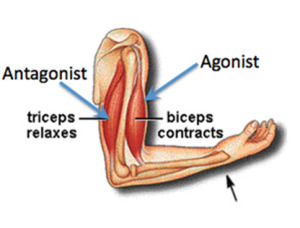The science of muscle development and movement goes far beyond the concept of aesthetics, vanity, and athletic performance.
At the fundamental level, muscular development within the human body (especially with age) becomes more of a function of maintaining balance and synergy.
Below is an illustrated example of just a few of the many detrimental changes that muscular imbalances can cause to your body over time if left unaddressed.

Some of the more common muscular imbalances are:
- Protracted (rounded shoulders)
- Forward head
- Anterior/posterior pelvic tilt
- Kyphosis (rounded/humpback)
- Knee adduction (knock knees)
The good news is most all of these are preventable with targeted exercise!
The bad news is, should one choose to forego exercise in this state, abnormal joint wear, inflamed joints, diminished range of motion, chronic pain, and even elevated fall risk are assured outcomes.
How this happens:
Most commonly, postural distortions develop over time and result from sedentary behavior, immediately followed by repetitive movement-related activity, and seated vocations.
Since virtually everything happens in front of you, the muscles on the front side of the body commonly experience over-development/tightness, while the muscles posterior (back of your body) become weak, and synergy is lost.
For those who experience prolonged bouts of sitting (more than 40% of waking hours), hamstrings and hip flexors become over-tight due to keeping the knees flexed/bent. Combined with weakened quadriceps (thigh muscles) it becomes difficult to completely straighten the knee.
Left unaddressed, this causes enormous problems in the lower back, hips, and knee joints, while compromising walking mechanics and the ability to stand from a seated position. To fix, strengthen the quadriceps muscles & stretch hamstrings/hip-flexors.
How this works:
For simplicity sake, we will use the elbow as an example:
This simple hinge joint is flexed (bent) by the two primary muscles on the front side of the upper arm, known as your biceps.

To straighten the elbow, the three muscles on the back side of the upper arm, known as the triceps, fire and push your arm straight.

Which of these two muscle groups would you guess to be the most crucial to keep functionally strong?
If you guessed triceps, you would be correct!
Why? There are two typical outcomes of weak triceps; elbow pain and shoulder pain. This is because your body will re-learn pushing mechanics (especially with age & low-exertion activity) and shift the emphasis for this movement from the elbows to the shoulders (which is a prime contributor to protracted/forward shoulder posture).
This concept applies to virtually all of the joints within your body. As the muscles on one side of a joint accelerate, you will have opposing muscles seeking to decelerate and stabilize.
To maintain proper synergy, these muscles each must be properly exercised! Unfortunately, this process is not automatic and mandates strength exercises for proper function.
*FIT FACT: (the muscles on the back-side of your body on average need 30% more strength exercise than those on the front!)
What this means for you, if you are not currently participating in strength exercises, the content of this article should provide compelling evidence as to why you should.
However, if you are exercising, it is essential to emphasize strengthening agonist/antagonist (pushing/pulling) muscles equally. Do not get stuck in the common rut of only training what you can see (front of body muscles).
Your efforts and calculated diligence will reward you with healthy/pain-free joints and empowered movement!
Joe Carson B.S. NASM-CPT/FAS/CN
Master Trainer/Functional Aging Specialist/Certified Nutritionist
Age-Well Arizona





